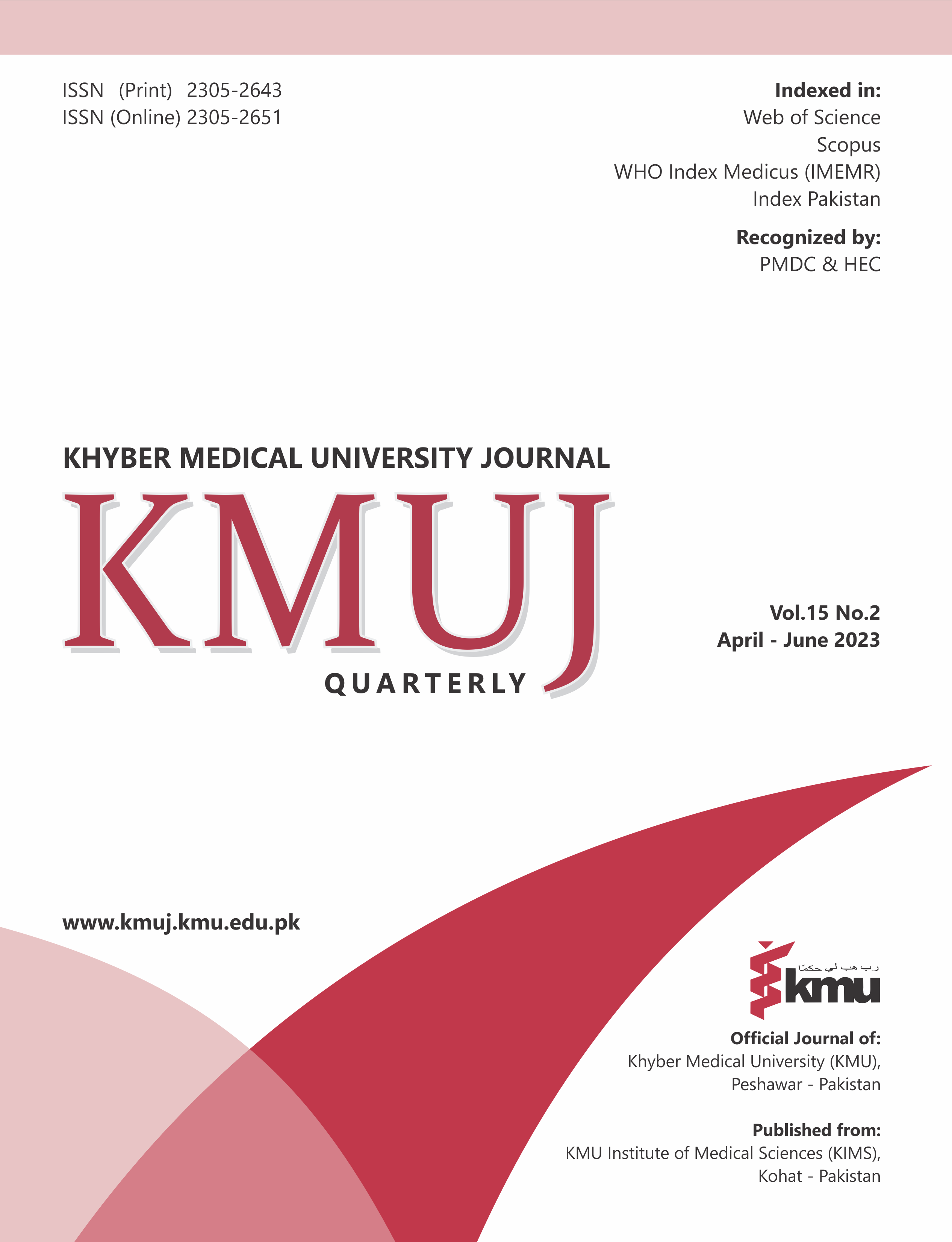Addictive social media usage during covid-19 pandemic: a case study of southern Punjab, Pakistan
Main Article Content
Abstract
OBJECTIVES: To investigate the impact of fear of missing out, belongingness, and peer pressure on social media addiction and to find out the gender difference in social media addiction.
METHODS: This cross-sectional survey was designed to collect data from 471 young adults through purposive sampling. The study was conducted from 28th January 2020 to 23rd May 2020 in southern Punjab (Multan, Bahawalpur, Vehari and Layyah) region of Pakistan. An online survey consisting of Fear of missing out scale, Belongingness scale, Peer pressure scale, and Addictive social media usage scale (ASMUS) was shared with participants along with the informed consent.
RESULTS: Out of 471 young adults 273 (58%) were females and 198, (42%) were males. Mean age of participants was 19.91±2.23 years. Fear of missing out is positively correlated with belongingness (r =0.26; p<0.01). Peer pressure is positively correlated with social media addiction (r =0.11; p<0.05) whereas belongingness is negatively correlated with social media addiction (r=-0.15; p<0.01). Fear of missing out, and peer pressure have a significant impact on social media addiction (R2=0.04, p<0.05) and belongingness has a negative impact on social media addiction (R2 = 0.04, p<0.001). Males have greater social media addiction with regard to socialization (Mean ASMUS=16.04±4.98) and information (Mean ASMUS=10.75±2.83) as compared to females.
CONCLUSION: Fear of missing out and peer pressure significantly predict social media addiction. Belongingness has a negative relationship with social media addiction. There exists a significant gender difference in social media addiction in terms of information and socialization.
Article Details
Work published in KMUJ is licensed under a
Creative Commons Attribution 4.0 License
Authors are permitted and encouraged to post their work online (e.g., in institutional repositories or on their website) prior to and during the submission process, as it can lead to productive exchanges, as well as earlier and greater citation of published work.
(e.g., in institutional repositories or on their website) prior to and during the submission process, as it can lead to productive exchanges, as well as earlier and greater citation of published work.
References
Billieux J, Maurage P, Lopez-Fernandez O, Kuss DJ, Griffiths MD. Can disordered mobile phone use be considered a behavioral addiction? An update on current evidence and a comprehensive model for future research. Curr Addict Rep 2015;2:156-62. https://doi.org/10.1007/s40429-015-0054-y
James TL, Lowry PB, Wallace L, Warkentin M. The effect of belongingness on obsessive-compulsive disorder in the use of online social networks. J Manag Inf Syst 2017;34(2):560-96. https://doi.org/10.1080/07421222.2017.1334496
Wong D, Amon K, Keep M. Desire to belong affects instagram behavior and perceived social support. Cyberpsychol Behav Soc Netw 2019;22(7):465-71. https://doi.org/10.1089/cyber.2018.0533
Oulasvirta A, Rattenbury TL, Raita E. Habits make smartphone use more pervasive. Pers Ubiquitous Comput 2012; 16:105-14. https://doi.org/10.1007/s00779-011-0412-2
Przybylski AK., Murayama K, DeHaan CR, Gladwell V. Motivational, emotional, and behavioral correlates of fear of missing out. Comput Hum Behav 2013;29:1841-8. https://doi.org/10.1016/j.chb.2013.02.014
Clayton RB, Leshner G, Almond A. The extended iSelf: The impact of iphone separation on cognition, emotion and physiology. J Comput. Mediat Commun 2015; 20(2):119-35. https://doi.org/10.1111/jcc4.12109
Tandor EC, Ferrucci P, Duffy M. Facebook use, envy, and depression among college students: Is facebooking depressing? Comput. Hum. Behav 2014; 43:139-46. https://doi.org/10.1016/j.chb.2014.10.053
Yushi. J, Naqvi M, Naqvi M. Using social influence processes and psychological factors to measure pervasive adoption of social networking sites: Evidence from Pakistan. Emerg Mark Finance Trade 2018;54(15):3485-99. https://doi.org/10.1080/1540496X.2017.1417834
Przybylski AK, Murayama K, Dehaan CR, Gladwell V. Motivational, emotional, and behavioral correlates of fear of missing out. Comput Hum Behav 2013;29(4):1841-8. https://doi.org/10.1016/j.chb.2013.02.014
Leary, MR., Kelly KM, Cottrell CA, Schreindorfer LS. Construct validity of the need to belong scale: Mapping the nomological network. J Pers Assess 2005;95(6):610-24. https://doi.org/10.1080/00223891.2013.819511
Singh S, Saini S, Goyal N. Development of peer pressure scale: reliability. Validity and factor structure. Indian J Health Wellbeing 2011;2(1):162-5.
Gupta S, Bashir L. Social networking usage questionnaire: Development and validation in an Indian Higher Education Context. Turk. Online J Distance Educ 2018;19(4):214-27. https://doi.org/10.17718/tojde.471918
Hayran C, Anik L, Gürhan Z .A threat to loyalty: Fear of missing out (FOMO) leads to reluctance to repeat current experiences. PLoS ONE 2020;15(4):1-17. https://doi.org/10.1371/journal.pone.0232318
Beyens I, Frison E, Eggermont S. I don’t want to miss a thing: Adolescents’ fear of missing out and its relationship to adolescents’ social needs, Facebook use, and Facebook related stress. Comput Hum Behav 2016;64:1-8. https://doi.org/10.1016/j.chb.2016.05.083
Salim F, Rahardjo W, Tanaya T, Qurani R. Are self-presentation of Instagram users influenced by friendship-contingent self-esteem and fear of missing out? Makara Hum Behav Stud Asia 2017;21(2):70-82. https://doi.org/10.7454/mssh.v21i2.3502
James TL, Lowry PB, Wallace L, Warkentin, M. The Effect of Belongingness on Obsessive-Compulsive Disorder in the Use of Online Social Networks. J Manag Inf Syst 2017;34(2):560-96. https://doi.org/10.1080/07421222.2017.1334496
Lueg JE, Nicole P, Sharon EB, Michael LC. Teenagers' use of alternative shopping channels: A consumer socialization perspective. J Retail 2006;82(2):137–53. https://doi.org/10.1016/j.jretai.2005.08.002
Tussyadiah SP, Kausar D, Soesilo PKM. The effect of engagement in online social network on susceptibility to influence. J Hosp Tour 2015;42(2):201-23. https://doi.org/10.1177/1096348015584441
Fogel J, Nehmad E. Internet social network communities: Risk taking, trust, and privacy concerns. Comput Hum Behav 2009;25(1):153-60. https://doi.org/10.1016/j.chb.2008.08.006
